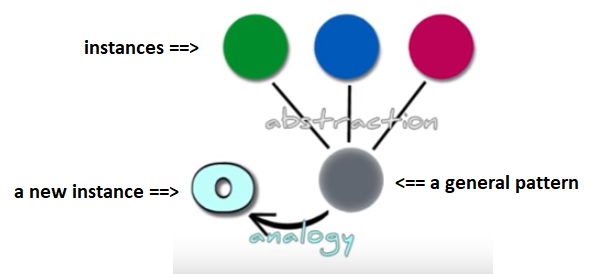This post is an attempt to summarize and expand on what I have already written on analogy and perspective by clarifying the relationship between the following concepts: analogy, perspectives, understanding, and imagination.
What is an analogy
Making an analogy involves two steps:
- Abstracting a general pattern from one or several instances, and
- Applying that pattern to a new instance.

Source of the original graph: https://www.youtube.com/watch?v=NVE8CaKsPPo
Step one (abstracting a pattern) by itself is essentially inductive reasoning.
Step two (applying the pattern) is looking at something from a particular perspective.
(I wonder if we can say that step two by itself is essentially deductive reasoning.)
The relationship between analogy and understanding
Let’s call the new instance we want to understand the “target”. The more you use analogy and apply different patterns to the target, i.e. the more you look at the target from different perspectives, the deeper your understanding of the target (I mentioned this idea here when discussing how seeing more instances of a concept perfects the concept).
The importance of having multiple perspectives
I already wrote about the importance of having a perspective. To begin to see/understand something, first you need to have at least one perspective (what I called a central belief). After you have a good view of the target from that perspective, you can then proceed to view it from a different perspective. But to see anything at all, first you must stand still.
Once you have a central belief, however, it is important to look at your target from different perspectives in order to gain a complete understanding of the target. Sometimes, it is impossible to have a direct understanding of something because we are not physically equipped for direct understanding (e.g. the parable of the blind men and an elephant and “seeing’ a tesseract, as discussed toward the end of this post). In that case, looking at the target from as many perspectives as possible is the best we can do.
Recap: analogy is the core of cognition
It is obvious now why analogy is the core of cognition. Analogy is the process of abstracting patterns and applying patterns. Applying patterns to something is the same as looking at something from a particular perspective. And the more perspectives you take to look at something, the deeper your understanding of that thing. Cognition is the process to obtain understanding. Hence, analogy is the core of cognition.
The role of imagination / Using analogies in mathematics
What role does imagination play in all this? In order to “look at” a target from different perspectives, we have to use our mind’s eye, i.e. we have to use our imagination.
So, the ability to understand is essentially the ability to to change perspectives, and such ability requires the faculty of imagination, as elaborated in this Ted Talk:
I am reminded of how the mathematician David Hilbert, upon hearing that one of his students had dropped out to study poetry, was quoted saying “Good, he did not have enough imagination to become a mathematician.”
It is interesting to note that both mathematicians and poets use imagination extensively, but their targets of understanding are different. Mathematicians use their imagination in abstracting and applying patterns in the most general sense possible for its own sake, while poets do the same thing (with their extensive use of metaphors) but only to the extent to capture and understand the human condition.
Here is another video on using analogies in math (I love how he explained the Euler’s identity this way!):
The link between imagination and understanding/knowledge also reminds of me of the famous Einstein quote: “Imagination is more important than knowledge. For knowledge is limited, whereas imagination encircles the world.”
I suppose this is so because imagination is part of the means to obtain knowledge. To use an analogy (ha): imagination is one machine in the cognition factory, and knowledge is what is produced by the factory (i.e. products). The number of products is necessarily limited by the amount of material (experience and data points) available to the factory, but the machine itself has unlimited potential to produce.
Patterns = Mental models (in the sense used by Charlie Munger)
I would just like to point out that what I mean by patterns here is the same as the concept of mental models as described by Charlie Munger. This is more of a note to self, since this is a concept that is very familiar to me. I have been a longtime subscriber of Farnam Street and I am currently reading 好好学习 by 成甲, who is also an advocate of the mental models theory.
Summary
- making an analogy = abstracting patterns + applying patterns
- applying patterns to something = looking at something from a particular perspective
- look at something from different perspectives = understanding something deeply
- the ability to understand is the ability to change perspectives
- the ability to change perspectives requires the faculty of imagination
- imagination is important in mathematics
- patterns = mental models
I feel like I have been writing about the same things year after year. While this may be evidence that my intellectual growth has been stagnant, I am always happy to go back to the fundamentals and clarify what I really think (my mental models, so to speak), for myself more than for anyone else. Insha’Allah, I will continue to optimize my mental models so that they resemble more and more to the reality, and I become closer and closer to Truth.
